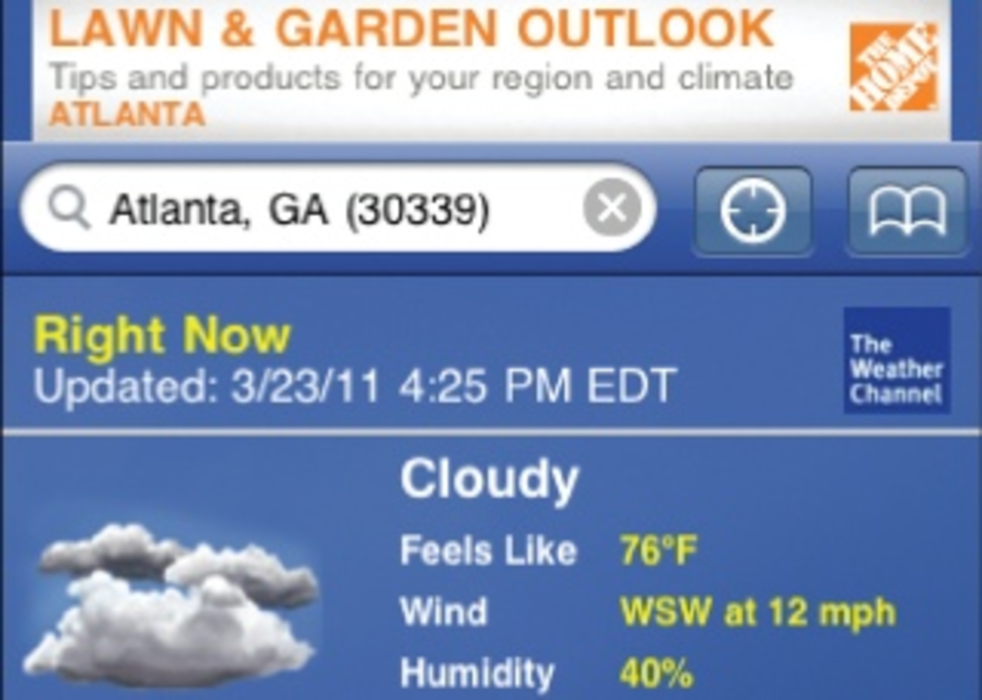Brands such as Burger King Corp., United Parcel Service of America (UPS) and Hotels.com are adopting in-app ads, capitalizing on the growing number of consumers using smartphones and the deep engagement provided by mobile applications. ?
The Weather Channel is helping its advertising partners gain deeper interaction with consumers by letting companies such as Westin Hotels & Resorts, The Home Depot and Burger King take advantage of its app’s ability to target consumers by location. Burger King ran ads in the app for its “Free Coffee Fridays” promotion, which displayed nearby franchises when a consumer used the app. However, since many brands and ad networks want to avoid taking location-based targeting too far, consumers who download The Weather Channel app must consent to allow the app to access their location. ?
“You have to take advantage of these devices,” says Pete Chelala, mobile manager at The Weather Channel. “People expect so much from these phones because of the native capa?bilities, so anything short just disappoints them.”?
UPS coordinated its adoption of in-app advertising with the debut of the “We Love Logistics” campaign last fall. Kevin Coffey, US advertising manager at UPS, says the channel helps the company naturally pitch its content and offerings to potential customers. “If you think about how you use your smartphone, you’re using apps,” he says. “That’s where usage is trending to.” ?
To illustrate the point, Coffey cites findings released by research firm The Nielsen Co. in April, which found that more than 60% of iPhone and Android owners use apps more than once a day. Coffey says the rising levels of interaction on mobile devices means consumers are more likely to interact with ads served on them. While UPS considers in-app ads a means by which to push content, such as videos demonstrating its products’ value, it has also included calls to action, such as email opt-ins and UPS app downloads. ?
Coffey says he is unable to provide detailed results from the company’s calls to action, but he adds that UPS’ in-app ads featuring video have generated 3% click-through rates. UPS also partnered with the BBC and Business Insider to run ads on the publishers’ iPad apps to target executives. ?
Similarly, Hotels.com has run ads within the apps of travel sites Kayak and TripAdvisor because they allow the company to engage consumers when they are in the hotel-booking mindset, notes David Young, senior director of online marketing for North America at Hotels.com.?
“Our intent is to drive traffic to our mobile site, especially given that those users are ready to shop and book now,” he says. The site runs ads that feature its hotel prices, and Young says the channel has “definitely been a stronger performer for us versus other mobile traffic acquisition channels.”?
However, advertisers must recognize that a consumer using an app is less willing to interrupt his or her experience than a consumer who sees an ad in a mobile browser. “I think that’s just a by-product of the fact that on the Web, people are more generally looking for information or engagement. There’s a little bit higher willingness to leave what they’re doing and interact with an ad,” says Tony Nethercutt, North America general manager for mobile ad network Mojiva. ?
An in-app ad’s creative can determine whether a consumer will disrupt his or her experience, says Paul Gelb, VP of mobile at digital agency Razorfish. “It takes a pretty compelling animated pull message to attract a consumer’s attention,” he says, adding that when executed well, a brand can engage the consumer at a deeper level.







